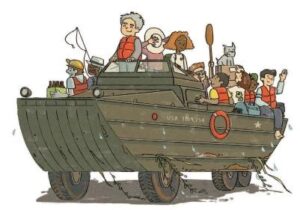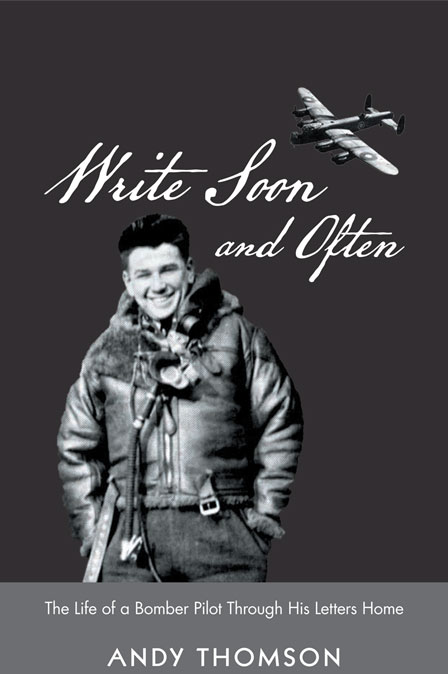D-Day DUKWs Drive Family to Camp
from the The Globe and Mail (Ontario Edition) 21 Jun 2024
thomsonFP-Globe art Illustration by Catherine Chan
An amphibious military vehicle that played a supporting role on D-Day became a crucial part of a multigenerational family
As the 80th anniversary of the D-Day landings came and went this year I was taken back to my family’s connection to the D-Day DUKWs. Most people drive cars to their cottages; our family drove DUKWs.
What’s a DUKW? It’s an amphibious military vehicle that played an important supporting role on D-Day. Its name is derived from an acronym based on its manufacturer’s coding: D, for the year of development, 1942; U, for a utility amphibious vehicle; K, for all-wheel drive; and W, for dual-rear wheels. The five-ton vehicle can carry two-and-a-half tons of supplies along with 25 soldiers and their equipment. That was just the right size for our needs, too.
I am part of a multigenerational family with several camps on the shore of Lake Pogamasing, about 75 kilometres northwest of Sudbury, near the Spanish River and CP rail line.
When my grandfather, W. B. Plaunt, closed down his lumber operation in 1940, he created a summer escape at a nearby former logging camp on Pog (our nickname for the lake). However, it was four kilometres from a railway stop with a river and a lake to cross. Accessing our camp in the summer was a logistical conundrum.
Back then, the trip to camp was accomplished in stages. Supplies and people had to be lifted, carried, lugged and transported by horse and buggy, jeeps, scows, boats and backpacks. First, we took the train from Sudbury to the whistle-stop at Sheahan. Then we crossed the Spanish River on a deteriorating wooden bridge before traversing along a two-kilometre logging road to reach the lake, where, finally, we loaded up a boat for the last three kilometres to our cabins.
The journey was more of a gruelling expedition than a pleasurable outing.
It was one of my uncle’s friends who suggested a solution. He had commanded a DUKW in the Pacific during the Second World War and convinced my uncle that it was the answer to our transportation woes.
Fortuitously, in the spring of 1959, a tour company was selling its DUKW and we brought it to Northern Ontario.
We were confident that our first DUKW trip to Pog could be accomplished in two days, with one night spent camping along the route.
Leaving our home in Sudbury, the highway driving was easy. But by the time we reached the Spanish River, two front springs had broken, penetrating the hull causing two large holes, allowing water to pour in near the engine. We hoped the three DUKW pumps, plus a backup one, would alleviate that concern.
There were other obstacles, too. The surging spring snow melt meant the Spanish River was full of pulp logs heading to the mill downstream.
At two o’clock, we started
– powered by six wheels, a 20-inch propeller and guarded by two teenagers on the front deck holding pike poles to redirect any logs. When we got bogged down, we wrapped the winch cable around a tree or boulder and crawled up the river.
While camping that night on a sandy shoal in the middle of the river we realized that some rubber covers had become dislodged, allowing water to seep in. That extra pump we carried was now keeping us afloat.
The second day started on smooth water and we were hopeful. But with no warning, the engine suddenly stopped. Too much water had drowned the engine. Discouraged, we caught the train back to Sudbury.
Later that summer, my uncle returned with friends to replace the engine, repair the leaks and drive the DUKW to our camp. What a celebration we had that long weekend.
From that point on, the DUKW more than lived up to its potential. Once we stepped off the train in Sheahan, we piled into that DUKW for a onehour drive on land and water right to the back door of our camps. It wasn’t always smooth sailing, but it rarely failed.
Our first DUKW lasted 15 years. As this amphibian was now indispensable, we purchased additional ones. The DUKWs hauled four generations of family, friends and dogs; our summer supply of groceries and fuel; boxcar loads of building supplies; and many of the lake residents as well. Every weekend, our flotilla of DUKWs and accompanying safety boats, would head across the lake to and from the railway.
After several decades, the usefulness of our DUKWs came to an end. Families now arrived by float plane, ATVs and most had a boat. By 2015, only two were barely operable. A family member bought the last one and sold it to a Dutch collector.
I do not know if the new owner took our former DUKW to the Normandy celebrations. But, in my imagination, it will be there, emerging from the ocean onto the beaches as so many of its comrades did eight decades ago.
Like the invading armies on D-Day, our family community would never have succeeded without that incredible amphibious vehicle.


